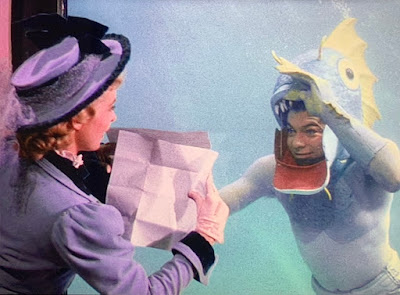Continuing my scene by scene dissection of Paramount's classic 1953 biopic Houdini. Last time Harry and Bess decided to cash in their Magic Ticket and live a domestic life. Today that plan goes up in smoke.
Chapter 10: Explosion
On his lunch break, Harry pays a shop boy (Jon Gardner) to lock him inside the safe when no one is looking. "It's alright. He said he can get out," the boy tells a mortified Mr. Hunter (Frank Orth). Hunter explains to the foreman (Frank Jaquet) that the safe has a 24 hour lock and can't be opened until tomorrow. It's unlikely there would be such a thing as time locks at this time, but it's necessary to explain why Hunter can't simply open the safe himself. When the foreman asks who's in the safe, the answer comes back, "Houdini." I believe this is the first time anyone in the film has called him "Houdini" directly.
The decision is made to blow open the safe, which they do in dramatic fashion. Harry emerges through the smoke, apple still in hand and coughing. "What'd you blow it up for," he asks. "You'd given me a little more time, I would have gotten out." Not surprisingly, he's fired on the spot.
There was another way to do this scene. They could have blown open the safe and found it empty. Then Houdini could have emerged from within the pack of workmen, apple in hand and smiling. This would have played as a magic trick for the audience and a nice "Houdini" moment, not unlike the Miners Hall vanish. He could still be fired for a stunt that cost the factory their best safe, so it works with the plot. But I guess it was wise to play it straight and make the attempt unsuccessful as we will see another safe escape later in the film.
Having lost his job, Houdini has to face the consequences back home. We dissolve to a tense dinner table with Bess and Mama. The silence speaks volumes. When they finally do speak, their veiled hostility is pretty humorous:
Bess: I still don't understand what you were doing inside that safe.
Harry: Told you a hundred times, I was having my lunch.
Bess then directly accuses him of getting fired on purpose so he could "go back to being a magician." Harry is resolute. "What's wrong with magicians? That's what I was when you married me."
Then comes the second explosion of the sequence as Bess leaps to her feet and shouts, "Well if you love your magic more than me, good luck to both of you, because I'm leaving!"
Mama implores Harry to go after her. Harry instead insults Bess's cooking. Mama retorts, "I made the soup!" Harry can't seem to win, so he gets up and leaves himself. It's a low point for all.
We then dissolve back to Coney Island. It's as if the movie has moved in reverse, using the same establishing shot from the start of the film. This nicely illustrates how Harry is trapped in a cycle of small time sideshow work, endlessly looping like the carnival rides on the midway. I do feel this is somewhat analogous to the Houdinis second stint with the Welsh Bros circus in 1898. Certainly at that point they must have felt stuck in an endless loop of small time work.
This time we see Harry playing "Oscar the Sea Serpent." Houdini never played an aquatic sideshow "freak" to my knowledge, but I like how this continues the idea of Houdini developing skills in his sideshow days that will serve him later in his career. Holding his breath and working underwater will play a major part in this movie.
Bess comes to see Harry. She has had a change of heart and through the glass shows him their boat ticket to Europe is now a one way ticket for two. Her sudden change isn't explained, but I think we can assume that after their big blow up she's realizes she can't stand in the way of her husband's nature. Obviously, Harry is thrilled to the gills.
One curious thing is the date on the ticket; June 12, 1902. The date the real Houdinis traveled to Europe was May 30, 1900. The filmmakers kept the month and day close, but why change the year to 1902? Real life gave them a gift as 1900 is wonderfully representative of a "new beginning." The 1976 TV movie The Great Houdinis takes full advantage of this. The ship, S.S. Ruratania, is also an invention. The ship the Houdinis sailed on was the S.S. Kensington (below).
These past few scenes have gone as far into fiction as this movie will travel. From this point on the movie tightens up on the analogous history as the career and exploits of Houdini kick into gear. And so will we next year!











Love it John. Keep it up.
ReplyDeleteYes, the break-downs of the movie are highly insightful!
ReplyDeleteThanks for the heads-up about this end-of-year deconstruction, John, as I missed it - and it's also wonderful! Leave it to you to spot the date 1902 on Bess's prop ticket to Europe! Great catch and a really good point. I also appreciated your comment, "Obviously, Harry is thrilled to the gills!"
ReplyDelete